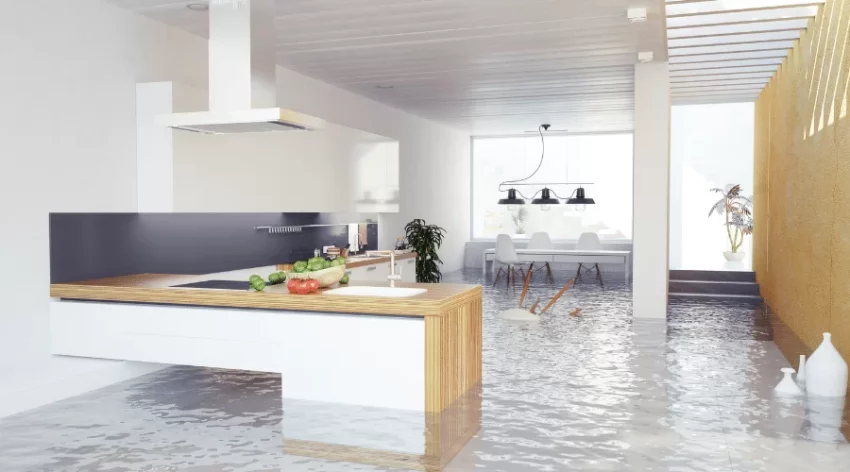A flooded kitchen is a homeowner’s nightmare, causing panic and stress. In this comprehensive guide, we’ll answer all your questions about flooded kitchens and provide you with the information you need to address this emergency effectively.
What to do if your kitchen is flooded?
First, stay calm and assess the situation. The steps you should take include:
- Ensure Safety: Before entering the flooded area, turn off the power and gas to prevent electrical hazards.
- Locate the Source: Identify the source of the flooding, which could be a burst pipe, appliance malfunction, or external factors like heavy rain.
- Stop the Flow: If possible, stop the source of the water. Shut off the main water supply if it’s a plumbing issue.
- Protect Belongings: Move valuable items to higher ground to prevent further damage.
- Remove Water: Use a wet/dry vacuum or mop to remove standing water.
- Ventilation: Promote air circulation by opening windows and doors to aid in drying.
Why is my kitchen flooding?
Understanding the causes can help you prevent future incidents:
- Plumbing Issues: Leaky pipes, damaged hoses, or a malfunctioning dishwasher or washing machine can lead to water damage.
- Natural Disasters: Heavy rainfall, storms, or flash floods can seep into your kitchen.
- Appliance Malfunctions: Faulty appliances, like a refrigerator or dishwasher, can leak and cause flooding.
- Clogged Drains: Blocked sink or drain pipes can lead to water backing up into your kitchen.
- Improper Installation: Incorrectly installed appliances or plumbing can lead to leaks.
What is a flooded condition?
A flooded kitchen refers to an area that has an excess of water, often due to an unexpected event or malfunction.
How long does it take to fix a flooded kitchen?
The time it takes to resolve a flooded kitchen depends on the severity of the damage. Minor flooding can be addressed in a day or two, while extensive damage may take weeks to repair.
How do you remove flooded water?
To remove water effectively:
- Use a wet/dry vacuum to extract standing water.
- Mop or sponge up remaining water.
- Use fans and dehumidifiers to speed up the drying process.
How do you fix a flooded room?
Fixing a flooded room involves:
- Identifying Damage: Assess and document damage for insurance purposes.
- Water Removal: Remove all standing water and moisture.
- Drying: Use fans and dehumidifiers to dry the affected area.
- Sanitizing: Disinfect and clean the space to prevent mold growth.
- Repairs: Repair or replace damaged materials, such as drywall or flooring.
How do you dry a flooded floor?
Drying a flooded floor involves thorough cleaning and ventilation. For carpeted floors, professional cleaning may be necessary.
How do you clean a flooded floor?
Cleaning a flooded floor includes:
- Remove Debris: Clear debris and dirt from the area.
- Disinfect: Use a mixture of water and bleach to sanitize the floor.
- Dry: Ensure proper drying to prevent mold and mildew growth.
Is it bad to sleep in a flooded room?
It’s not safe to sleep in a flooded room due to electrical hazards, potential health risks, and safety concerns. Ensure the room is dry and safe before using it.
What are the dangers of a flooded house?
Dangers of a flooded house include:
- Electrical Hazards: Water can damage electrical systems and pose a risk of electric shock or fires.
- Mold Growth: Standing water can lead to mold and mildew growth, which can harm your health.
- Structural Damage: Flooding can weaken the structure of your home.
- Health Risks: Floodwater may contain contaminants and bacteria.
What appliances can be saved after a flood?
The salvageability of appliances depends on the extent of the damage. Consult a professional to assess the condition of your appliances.
What are the damages caused by flooding?
Flood damages include:
- Structural Damage: Weakening of building foundations and walls.
- Mold Growth: Mold can develop in as little as 24-48 hours.
- Health Risks: Exposure to contaminated floodwater can lead to health issues.
- Content Damage: Loss of personal belongings and furniture.
Remember, it’s essential to contact professionals for extensive damage and consult your insurance provider for coverage options.
Conclusion
A flooded kitchen can be a stressful and overwhelming situation, but with the right knowledge and quick action, you can minimize damage and ensure safety. By understanding the causes, taking immediate steps to mitigate damage, and seeking professional help when necessary, you can successfully address a flooded kitchen. Always prioritize safety and consult with experts to handle more severe flooding incidents.
For more information and tips on home maintenance, visit home motivated.
